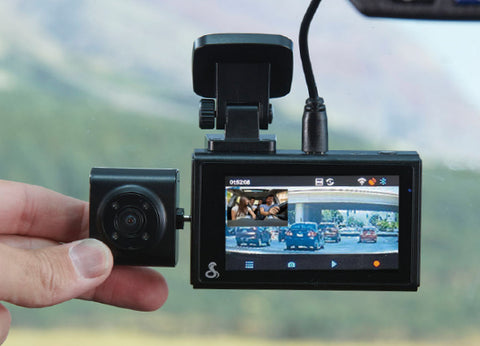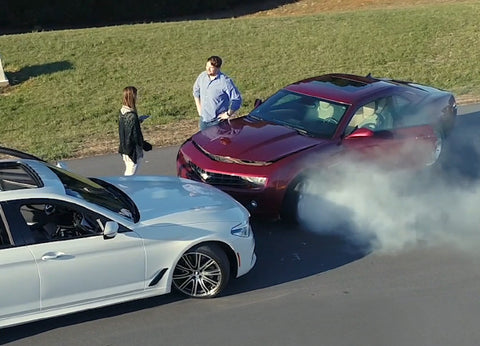How to Choose the Best Dash Cam
A wide variety of dash cams are available on the market, but choosing the best dash cam for your car depends on your specific circumstances and needs. Not everyone needs or wants the same features – a parent of a new driver might want internal cabin recording, for example, while the best dash cam for someone who loves road trips might offer more memory or easily downloadable video. Understanding what dash cam features are available is the first step toward choosing a device that offers the technology you need to stay safe and aware on the road.
Which Dash Cam Features Do I Need?
The best dash cam for your needs will depend on your driving habits and how your car is used. Before you rush out to buy the least expensive camera available, you'll want to make sure that the device you're buying delivers the features you need and can be used effectively in your vehicle.
Consider these features when buying a dash cam:
Power Source - Most cameras come with a 12V power adapter cord that can be plugged into a car's auxiliary power outlet. You'll need to make sure that you have this outlet in your car and that isn't being used by a different device. If you want to hardwire the dash cam directly into your vehicle's electrical system, make sure that you choose a camera that allows for this. You may also need a special kit that's sold separately to hardwire your dash cam; professional installation may be preferred.
Video Quality - While you may be tempted to save money by going with a lower quality video, the best dash cams have at least a 1080P resolution. Higher resolutions allow you to see more details in the video such as license plate numbers or street signs, which can provide important evidence during a crash or other incident. While resolution is a key contributor to video footage quality, visibility, camera angles, and low light capabilities are also important factors to consider.
Multiple Cameras - Every dash cam will have a front-facing camera, but it only records what's happening in front of the car. For added protection, consider a system with a rear camera as well. This provides additional protection and peace of mind to capture everything that happens around you. If you have a new driver in the family, or if you drive for a ride-sharing service, it's a good idea to choose a dash cam with an interior or cabin-view as well. This style of camera records what happens inside the car, which can show if a driver was distracted or someone else in the vehicle caused a disruption that resulted in an incident.

Video Screen - This popular dash cam feature allows you to see exactly what your camera is recording so you can feel confident that it's set up and orientated correctly. A dash cam with a screen may also allow you to see actions taking place outside of your immediate view, particularly if you have a rear or cabin-view camera. While video screens are a useful feature, it's important that they not become a distraction to the driver.
Emergency Video Lock - Many dash cameras use continuous loop recording, which means that they record over older video to save memory, but the best dash cams lock the video when they detect a sudden stop or possible crash through a built-in G sensor. This prevents important videos from being overwritten, preserving possible evidence.

Temperature Protection - If you live in an area with extreme heat or cold, these harsh temperatures can damage a dash cam that's not built to handle them. Choose a dash cam that is specifically designed to handle extreme temperatures.
Cloud Video Management - Most dash cams have an SD card slot – all Cobra models even include a high-capacity SD card with the dash cam – that can save video recordings directly onto a memory card in the device. Even the largest memory cards have limited space, however, and a separate card reader may be needed to transfer your videos to another device. A system with cloud video management allows you to store, edit, and share videos wirelessly. This makes the process of getting videos off your camera easier and allows you to keep important or interesting videos without taking up space on your dash cam's SD card.
GPS - While many of our personal electronics have GPS built-in, having this dash cam feature can be a literal lifesaver in the case of an accident. GPS records your location information, which is useful in identifying where an accident or other incident in a recording occurred. If your dash cam has emergency Mayday alerts (a feature included on all Cobra SC series smart dash cams), you can set up an emergency text message and email with your GPS location and a help message to be sent in the event of a severe collision with an unresponsive driver.
Recording When the Car Is Not Moving - A more advanced feature that's usually only available in dash cams that are hardwired or plugged into an "always on" socket, some dash cams can be set up to help protect your vehicle even when you're not driving. Parking mode, or a similar feature, monitors your car for G sensor impacts, recording and saving video footage when a bump or collision is detected while you’re away from your vehicle.

As you can see, there are many considerations to take into account that make how to choose a dash cam a little more complicated than it might seem. When you take the time to really consider your needs, both in terms of safety and convenience, you're more likely to choose the best dash cam for your vehicle and driving habits.
Do Dash Cams Have Monthly Fees?
In general, there is no monthly fee for simply using a dash cam. However, some manufacturers may charge a monthly fee to use specific dash cam features. Cobra dash cams are supported by several different apps, depending on the model of camera, but these apps are currently free to download and use (as of 2021). Other manufacturers that offer cloud video management and other advanced features may charge you a monthly fee to use them.




 |
|